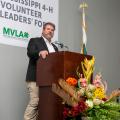History of Extension
The University was established in 1878 as the Agricultural and Mechanical College of the State of Mississippi. It became part of the nation's land-grant system created by the Morrill Act, passed by the U.S. Congress in 1862. Its mission was to educate students in "agriculture, horticulture, and the mechanic arts...without excluding other scientific and classical studies."
Although the University has greatly expanded its educational opportunities in a number of arts and sciences disciplines, its commitment to agriculture has not diminished. For more than a century, this commitment has benefitted Mississippi's major industry and all of its people in immeasurable ways. The University's Division of Agriculture, Forestry, and Veterinary Medicine exists because of the state and the nation's commitment to making America's food and fiber system the most effective one in the world. That commitment dates to the mid-19th century and is as up-to-date as the space age. As a matter of fact, agriculture forms the indispensable base on which all our modern technological and economic advances rest.
The nation's more successful farmers have always been those that sought the most reliable information about agricultural practices. Among their ranks are founding fathers George Washington and Thomas Jefferson. These gentlemen farmers maintained detailed production records and networks of contacts for information exchange.
As the United States developed, influential men like Washington and Jefferson expressed greater interest in a more scientific approach to agriculture. At the same time, interest in the general welfare of the common people increased. The federal government responded with a series of actions beginning with the establishing of the United States Department of Agriculture as a Presidential cabinet-level department in 1862.
Broader training and deeper scholarship in production and marketing of agricultural products was needed to enhance the nation's major industry. This need fueled one of the nation's greatest contributions to modern education--the agricultural and mechanical college. This approach to education combined the scholarly with the practical with the avowed purpose of improving opportunity for the masses.
The Morrill Act of 1882 established these colleges nationwide. Called the land-grant system, this class of colleges was originally endowed by grants of public lands in the developing western United States. Mississippi joined the movement with the first assignment of land-grant funding to Alcorn University and the University of Mississippi in 1871. The State A&M College near Starkville was established as Mississippi's land-grant institution in 1878.
In 1887, the Hatch Act established the agricultural experiment station system, modeled on European stations, but with a distinctly American interest in applied research. The Mississippi legislature responded with its experiment station act in 1888. Although the federal act bears the name of Missouri's William Henry Hatch, significant credit must be given to our state's Senator James Z. George. He introduced the first experiment station bill in 1885 only to see it stall in the House of Representatives.
The Second Morrill Act, passed in 1890 after 18 years of debate, provided for direct annual appropriations to each state to support its land-grant college.
The existence of land-grant colleges and experiment stations resulted in a growing logjam of knowledge that needed to be made available to the farmer and farm family in the field. A variety of activities including farmers institutes, agricultural societies, and corn and tomato clubs tried to meet these needs. In response, the Smith-Lever Act of 1914 established cooperative extension work.
Publications
News
Artificial intelligence is the most recent tool in the toolbox for the Mississippi State University Extension Service in its ongoing efforts to provide the best research-backed information to the residents of the state.
MSU’s Agricultural Autonomy Institute, or AAI, hosted the National AI in Agriculture and Natural Resources Conference on March 31-April 2 in Starkville. ExtensionBot was the first item to be addressed at the conference.
“Extension does that?” That’s the typical response when we tell people about all the services MSU Extension offers. We’ve been a trusted partner for families and communities in Mississippi since 1914, offering programs, resources, and expertise in a variety of areas.
Success Stories
We’re in a busy time of year, and I wanted to share a few of the great things we are doing this summer in MSU Extension.
Connecting teens with law enforcement officers can foster positive relationships in the community, and it may even inspire some young people to join the force.
Photos by Kevin Hudson
Dear friends,
Welcome to Extension Matters! We will bring you the best success stories about Extension clients every Friday to brighten your weekend, and I’m excited to welcome you to our new format.






